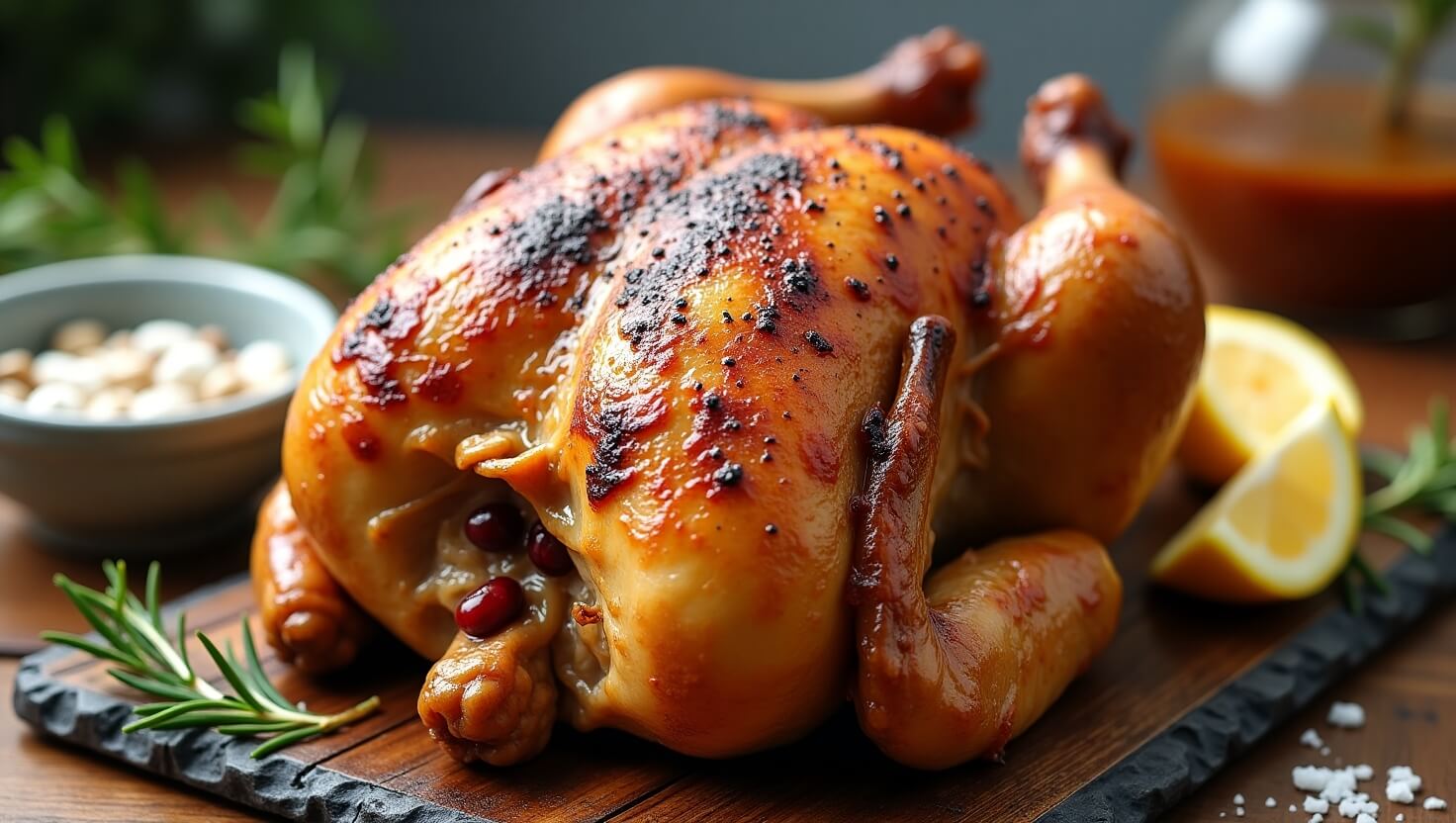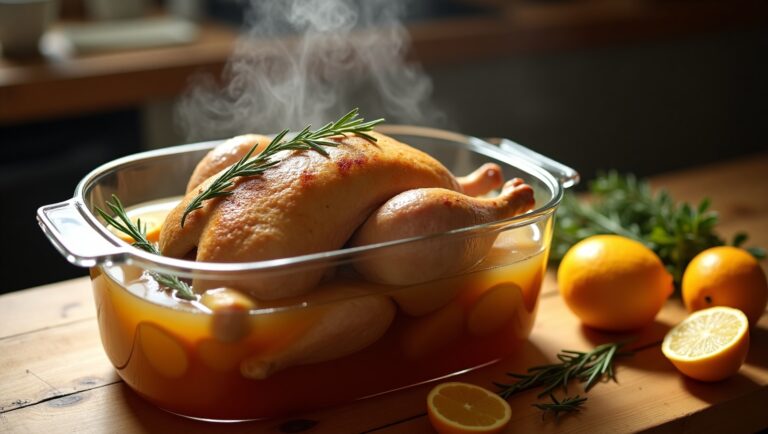Brined chicken: How to make perfect juicy chicken

Every home cook has faced the disappointment of dry, bland chicken. Brined chicken changes this, turning ordinary poultry into a culinary masterpiece. It will have your family and friends asking for more.
Imagine biting into a juicy chicken breast that’s full of flavor. Brining does more than just season the chicken. It’s a technique that professional chefs use to make their dishes stand out.
Brined chicken offers a unique eating experience. By soaking chicken in a saltwater solution, you get a chicken that’s moist and full of taste. Whether it’s for a family dinner or a special event, brined chicken is your secret kitchen weapon.
Key Takeaways
- Brining dramatically improves chicken’s moisture and flavor
- Works for multiple chicken cuts and cooking methods
- Simple technique that transforms ordinary chicken
- Adds depth and richness to your culinary repertoire
- Professional chef-level results at home
What is Brined Chicken and How is it Made?
Brining chicken makes ordinary poultry into a tasty, juicy meal. Learning how to brine chicken opens up a simple yet powerful way to improve your cooking. It helps you make dishes more flavorful.
The brining process involves soaking chicken in a saltwater solution. This solution helps keep the chicken moist and enhances its taste. Different brining techniques can make even the driest chicken tender and juicy.
Understanding the Brining Process
Brining works through osmosis, a scientific process. When you make a homemade brine solution, salt breaks down chicken proteins. This lets the chicken absorb more liquid.
This means your chicken stays moist while cooking. It also develops a deeper, more complex flavor.
Common Ingredients for Brining
- Kosher salt (primary ingredient)
- Water
- Sugar (optional)
- Herbs and spices
- Garlic
- Peppercorns
Different Methods of Brining
- Wet Brining: Submerging chicken in liquid saltwater solution
- Dry Brining: Rubbing salt directly on chicken skin
- Quick Brining: Short-term salt treatment for faster preparation
Each method has its own benefits for making delicious, moist chicken. It will surely impress your family and friends.
Advantages of Brining Chicken
Discovering the benefits of brining can change your cooking game. It makes your chicken dishes better. Brining brings out amazing flavor and juiciness.
Both pro chefs and home cooks love brining. It does more than add moisture. It makes chicken taste amazing, impressing everyone.
Enhanced Flavor Profile
Brining chicken changes its flavor in a magical way. Salt and seasonings go deep into the meat. Your chicken will taste better all over.
- Intensified taste throughout the entire piece of meat
- Balanced seasoning from the inside out
- Potential for complex flavor combinations
“Brining is like giving your chicken a flavor passport – it travels everywhere!” – Culinary Expert
Improved Moisture Retention
Brining’s science is cool. Salt helps chicken keep water, making it juicy. This stops chicken from getting dry and tough.
| Brining Method | Moisture Increase | Flavor Intensity |
|---|---|---|
| Wet Brine | 25-40% | High |
| Dry Brine | 15-30% | Medium-High |
Knowing brining’s benefits can make your chicken dishes amazing. They’ll be juicier, tastier, and always delicious.
How Brining Affects Chicken Texture
Brining poultry changes how chicken feels and tastes. It’s a technique that makes meat more tender and flavorful. Let’s dive into the science behind it.
Brining works at a cellular level. Soaking chicken in saltwater changes its protein structure. Salt breaks down these proteins, making the meat more tender and moist.
The Science of Protein Modification
Brining changes chicken’s cells in a unique way. The salt solution unwinds proteins, allowing water to fill in. This leads to:
- Enhanced moisture retention
- Softer meat texture
- Reduced protein muscle tension
Texture Comparison: Brined vs. Non-Brined Chicken
Brined chicken is a world apart from non-brined. It has:
- Juicier internal structure
- More uniform texture
- Reduced risk of dry, tough meat
“Brining is like a secret weapon for transforming ordinary chicken into an extraordinary culinary experience.” – Professional Chef Recommendation
Brining your chicken is a game-changer. It makes the meat tender and full of flavor. Your dinner will be a hit every time.
Best Types of Chicken for Brining
Choosing the right chicken for brining can greatly improve your cooking. Not all chicken cuts are the same when it comes to brining. Knowing which parts work best will help you get juicy, flavorful meat every time.

When looking at brined chicken options, consider the unique traits of different chicken parts. Each cut absorbs and flavors differently based on brining methods.
Whole Chickens vs. Specific Cuts
Brining whole chickens has many benefits:
- Even moisture distribution throughout the bird
- Consistent flavor in all meat sections
- Better results for roasting and whole-bird recipes
Dark Meat vs. White Meat Considerations
Your brining techniques will vary based on the meat type:
- Dark meat (thighs, legs) typically requires:
- Longer brining times
- Stronger salt concentrations
- White meat (breasts) works best with:
- Shorter brining periods
- Lighter salt solutions
Pro tip: Chicken breasts are most prone to drying out. Brining them helps keep them moist and tender.
Popular Brining Recipes
Exploring brined chicken opens a world of flavor and moisture. The best brined chicken recipes turn ordinary poultry into amazing dishes. They will make your cooking skills shine.
Making a homemade brine solution is easy. Just understand the basics and try different ingredients. This way, you can create your own special flavor.
Classic Brine Solution
A classic brine solution includes:
- 1 gallon of water
- 1 cup kosher salt
- 1/2 cup brown sugar
- 2-3 bay leaves
- Fresh herbs like thyme or rosemary
Creative Flavor Combinations
Try these unique flavor ideas to spice up your brining:
- Citrus Burst: Add orange and lemon zest to your brine
- Asian-Inspired: Use soy sauce, ginger, and star anise
- Smoky Southwestern: Mix in chipotle peppers and cumin
The secret to a great homemade brine is finding the right balance. Start with these recipes and add your own twist to brined chicken.
How Long Should You Brine Chicken?
Knowing the right brining time is key when brining chicken. The time you brine can make your chicken juicy or too salty.

The brining time depends on the chicken cut and its weight. Paying attention to timing is crucial for the best results.
Recommended Brining Times
Different chicken cuts need different brining times:
- Whole Chicken (4-5 lbs): 8-12 hours
- Chicken Breasts: 30 minutes to 2 hours
- Chicken Thighs: 1-2 hours
- Chicken Wings: 30 minutes to 1 hour
Identifying Over-Brining
It’s important to know when chicken is over-brined. Overly brined chicken tastes too salty and feels mushy.
| Signs of Over-Brining | Recommended Action |
|---|---|
| Extremely salty taste | Reduce brining time |
| Mushy or soft texture | Shorten brine duration |
| Overly wet appearance | Decrease salt concentration |
To get the best results, use an easy brining method. Pay close attention to timing and watch your chicken closely.
Tips for Perfectly Brined Chicken
Mastering brining techniques for chicken can make your cooking stand out. The right steps can lead to flavorful brined chicken that wows your guests.
For perfect results, pay close attention to detail and understand key principles. Knowing what to watch for and how to try new things makes brining easier.
Avoiding Common Mistakes
When brining chicken, several mistakes can ruin your dish:
- Never use metal containers for brining, as they can react with salt
- Maintain proper refrigeration during the brining process
- Avoid over-brining, which can make chicken too salty
- Rinse chicken thoroughly after brining to remove excess salt
Experimenting with Brine Variations
Creating flavorful brined chicken means getting creative with your ingredients. Try these exciting variations:
- Citrus-infused brine with lemon and orange zest
- Herb-packed brine using fresh rosemary and thyme
- Spicy brine with chili peppers and garlic
- Sweet brine using apple cider and brown sugar
Remember, each brine variation adds unique flavors to your chicken. So, don’t hesitate to experiment and find your own style.
Health Considerations for Brined Chicken
Exploring brined meat means looking at health impacts. Brining chicken can change what you eat, especially sodium levels. It’s important for your health.
Sodium is a big deal with brined chicken. The meat soaks in saltwater, raising sodium. Too much sodium can harm your health, like:
- High blood pressure
- Increased heart disease risk
- Water retention
- Potential kidney strain
Understanding Sodium Levels in Brined Chicken
Brined chicken has more sodium than regular chicken. Sodium can go up by 15-30% per serving. Moderation is key for a healthy diet.
Healthy Brining Alternatives
For a healthy diet, try these brining tips:
- Use low-sodium salt substitutes
- Reduce brining time
- Experiment with herb-based marinades
- Rinse chicken thoroughly after brining
Knowing these tips helps you enjoy brined chicken without losing nutritional balance.
Brined Chicken in Culinary Culture
Brined chicken has become a key technique in cooking, known worldwide. It changes how we cook poultry. Chefs and home cooks alike use it to make chicken taste better and feel softer.
In the American South, brining is key for amazing fried chicken. It makes the outside crispy and the inside juicy. In the Mediterranean, herbs like rosemary and thyme are used. They add deep flavors to the chicken.
Top chefs at famous restaurants like Per Se and Daniel Boulud’s places use brining. They do this to keep their chicken moist and full of flavor. This way, they serve chicken that’s both tasty and tender.
Exploring brined chicken shows it’s more than just cooking. It’s an art that connects home cooking with professional skills. Learning about brining can make your chicken dishes delicious and tender, whether for a family meal or a special occasion.







